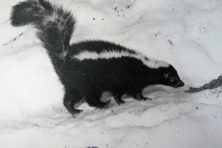The Story Behind The American Pelecinid, the June Bug, and Skunks
- Share
- Tweet
- Pin
- Share
Every time I see holes in a lawn dug by skunks, I am reminded of my first close look at what I thought was an Ichneumon Fly. An entomologist friend had brought it and, being trained in the study of butterflies, moths, flies, beetles, bugs and other insects, quickly informed me that I was admiring an American Pelecinid (pel-e-SY-nid) Wasp.
Most people would look at this glistening black wasp with its long, slender abdomen, perhaps rear back a little, and ask, “What kind of a bug is that?” Little do they realize that all insects are not bugs. Yes, there are about 50,000 species of bugs in the world, including the Soldier Bug, Stink Bug, Ambush Bug, Bedbug, Water Strider, Cicadas, Spittlebugs, Leaf-hoppers and Aphids. However, there also are hundreds of thousands of other insect species that are not bugs.

The fearsome-looking, but harmless, American Pelecinid plays a vital role in controlling the June Bug population.
Surprisingly the attitude of many people toward insects generally is not good. Their motto could very well be, “Insects bug me!” Little do they understand the importance of many insects, for example, in the pollination of various fruit and other food crops.
Thousands of animal food chains include insects. Many birds exist primarily upon insects. The number of insects that prey upon other insects is very large. Indeed, without predatory insects we would be in deep trouble.
Unfortunately, common interests of people and many insects overlap. Take for example farm, orchard and garden crops and one can itemize hundreds of insects or their larvae eating the very things you are hoping to harvest. Sadly, pesticides and even those highly inefficient electronic bug “zappers,” if those are the chosen final solutions, end up killing as many or more beneficial insects as harmful species.
One insect, the “May” beetle or June Bug, has been the indirect cause of extensive damage by hungry Skunks in past summers. The bulky, shiny, reddish brown to nearly black adult, one of about 1,300 North American species, laid eggs in someone’s lawn a few summers ago. The eggs hatched into white larvae with brown heads. Eventually, by the end of the third summer, they had grown to about two inches in length.
Their preferred habitat includes deciduous forests, grasslands and lawns. The subterranean caterpillars feed primarily on decaying vegetable matter but also consume the roots of living trees, shrubs, and herbs such as grass. Finally, after three summers of eating, the larvae pupate in earth-made cells in the soil where they undergo their final changes, eventually emerging as adults in spring.
The June Bug name of the adult is misleading because they are not bugs, they’re beetles which, in turn, also are insects.
Getting back to the feature of this story, the American Pelecinid Wasp, most folks would see little but a dangerous stinging creature in this handsome insect. This happens to be the only Pelecinid Wasp in the entire country. Females are common while males are comparatively rare.
The two-inch female has an extremely long, slender abdomen and ovipositor, through which her eggs will be laid. She shoves her needle-like abdomen deeply into the soil to locate host larvae (LAR-vee, plural of larva) below. Finding one, she lays an egg at a time, each on a separate host larva. The Pelacinid larvae hatch and burrow into the hosts, killing them. Scavenging on the remains, they eventually pupate there.
Now for the surprise. The host larvae upon which the American Pelecinid Wasps lay their eggs happen to be the June Bugs! Here is a case where the unknowing person would be inclined to flatten the slender black wasps while plugging up the gaping holes made in their lawn by a skunk in search of the very same grubs for which the wasp was probing.
In this case it’s the fearsome looking but totally harmless wasps you should be protecting in order that their natural parasitic tendencies (of the larvae) will help to control the June Bug population. Very likely the thousands of square miles of carefully and expensively manicured lawns along with the vast acreage of food crops have helped to increase the June Bug population. Now if only we could figure out a way to enlarge the number of Pelecinid Wasps, people wouldn’t have so much trouble with skunks digging up their lawns!



